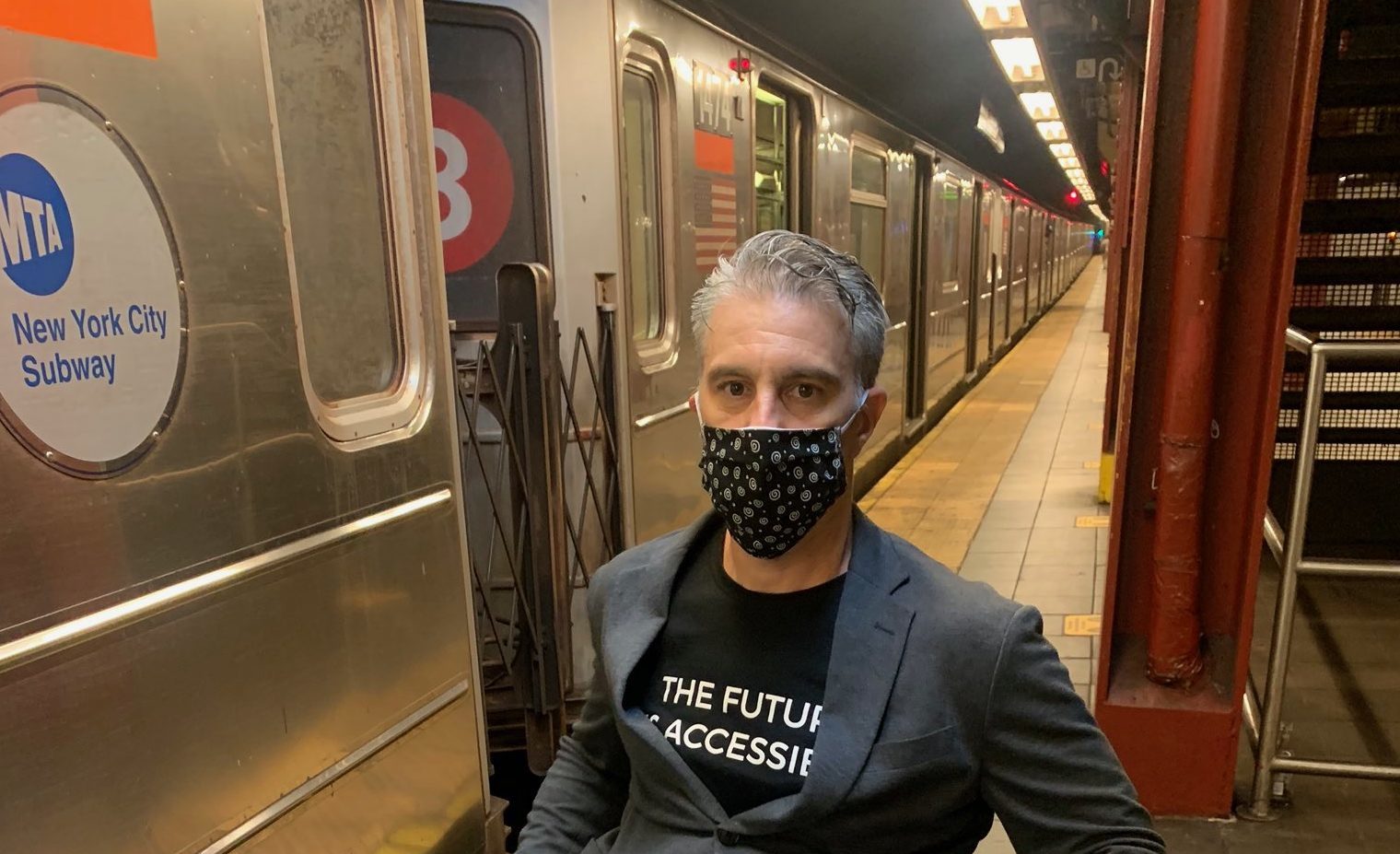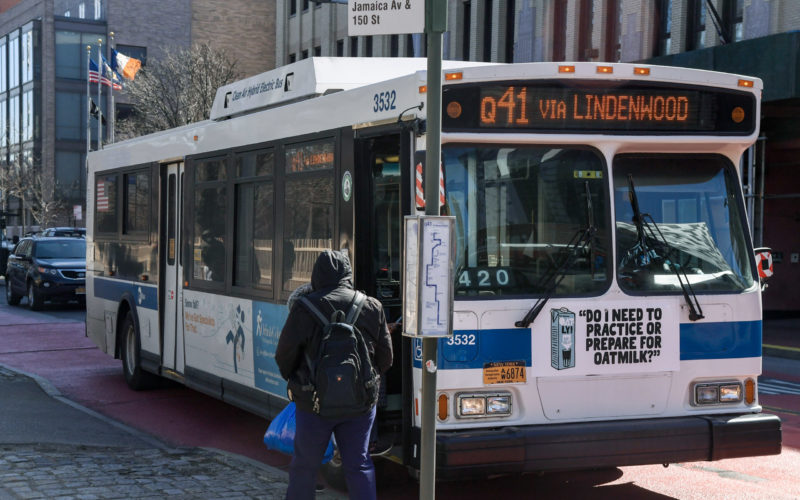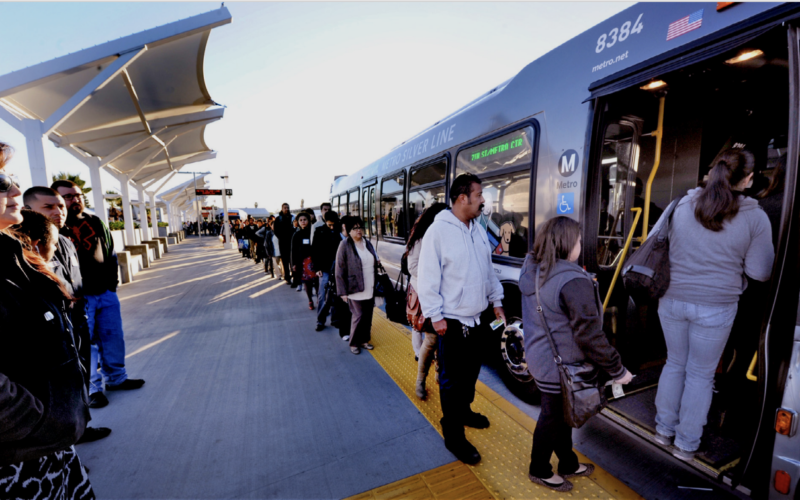
New York’s MTA is the most inaccessible transit system in the country, with elevators in only 25% of its 472 subway stations. Until recently, transit riders with disabilities have been without representation on the MTA’s board. That changed in June, when Victor Calise, a commissioner of the New York City Mayor’s Office for People with Disabilities (MOPD) and daily subway rider who uses a wheelchair, was approved unanimously by the New York State Senate.
His appointment comes at a critical time for the agency. The MTA’s 2020-2024 Capital Program, which pledged to make 70 additional subway stations accessible, has stalled because of the financial fall-out from COVID-19. In the coming months, the MTA will be forced to make decisions about which capital projects to prioritize. It’s more important than ever for people with disabilities to be at the table, guiding those decisions.
TransitCenter spoke with Commissioner Calise about his priorities for his tenure on the MTA Board, and why it is so important to include people with disabilities into design and decision making processes at public agencies.
Tell us about yourself. What has been your experience getting around New York City on transit?
I grew up in Ozone Park, Queens, and I was injured in a bike accident in 1994. After college, I went to work for an advocacy non-profit called Eastern Paralyzed Veterans Association, which later became the United Spinal Association. I worked on various issues throughout the organization, including integration of people with disabilities into sports and on advocacy issues around voting, stem cell research, and transportation equity. After that I worked with sports franchises to integrate disability into sports.
In 2006, I was recruited into the New York City Parks Department as its first accessibility coordinator. This might be me being a pompous New Yorker, but the NYC Parks Department is the most accessible in the world. That’s because the department doesn’t view the ADA as a “cost,” but rather as a design feature that benefits everyone.
From there I was recruited to the MOPD, where I’ve worked on many issues to make NYC the most accessible city in the world – from employment, transportation, healthcare, and financial empowerment for people with disabilities. All of this has been in consultation with the disability community.
Living as a New Yorker with a disability, I realize there are many gaps in our accessible transportation system. When I started the job as MOPD Commissioner, for instance, there were few accessible taxis in NYC. We’ve changed the landscape with yellow accessible taxis as well as for-hire vehicles.
Our subway system has a long way to go. I live right in front of an M10 bus stop, but the A train at 104th Street is not accessible. My closest accessible stop is 96th and Broadway, which is about a mile away. Once I’m on the 1/2/3, I have the ability to get most places I need to go.
Accessible transportation is something that doesn’t only benefit people with disabilities. It benefits everyone – parents with strollers, people with injuries, people with luggage.
Unless you’re reappointed by the next mayor, your term will end with Mayor de Blasio’s in 2022. What goals do you hope to achieve in the next year and a half as an MTA board member?
If there are cuts to the 2020-2024 MTA Capital Program, I want to make sure the cuts are not just to accessibility projects but that they are made equitably across the board. That is an important issue that I have raised at the MTA board meetings.
I want to bring awareness to disability. I’m the first wheelchair user on the board – and I’m humbled – but I want people to understand that disability needs to be part of everything that the MTA does. People with disabilities are the largest minority group in the world, and should be represented in positions of power and able to make decisions for themselves.
I want to make sure that New York City Transit’s Accessibility Team is supported, because they have really brought accessibility to the next level throughout that agency.
I’m also interested in the future of the MTA’s Access-A-Ride paratransit program. How do we make sure that it gives riders what they need: a service that is on-time and on-demand?
In a constrained budget, capital priorities like station accessibility, signaling, and other big-ticket items are at risk of being scaled back. How will you navigate those choices as an MTA board member?
Right now, I’m concerned about federal rescue funding. Will it come through, will it save us, and will it save the 70 stations the MTA plans to make accessible in the 2020-24 MTA Capital Program?
And if there are cuts, how do we make sure that priority stations remain? What are those priority stations? What does the community think? If there are cuts across the board, they need to be across the board, they can’t just be made to accessibility.
We aren’t the only transit system in the country that is suffering right now. Agencies like Boston and Chicago have their issues, too. I hope the HEROES Act passes – there are a lot of provisions within the Act that would help people with disabilities.
If federal rescue funding comes through, are you confident that the MTA will make good on its commitments to the disability community made in the 2020-2024 MTA Capital Program?
This is a tough question. Right now, I’m hearing that the rescue package will get us through the end of the year. [Editor’s note: Funding from the CARES Act – passed by Congress in March – is expected to last the MTA until the end of July.]
But there are so many more questions. Will we come up with a vaccine? Will people feel comfortable coming back to transit? The reality is that if people aren’t feeling comfortable, and we don’t bring revenue back to the system, then we are going to be facing serious challenges. Again, if there are cuts, we need to make sure that cuts are not just made to people with disabilities, but they are made across the board.
The COVID-19 pandemic has affected people with disabilities particularly hard. In thinking about the MTA’s response to this community during the pandemic, what has gone well and what could be done differently?
I have been hearing complaints about loading in the front of the bus, and how some drivers have not been able to do that properly while maintaining 6 feet of social distance. That has been a concern and continues to be a concern – and I will be monitoring that.
Some of the things that have gone right are the increase in cleaning of buses, trains and paratransit vehicles. I also think that cancelling the policy of shared rides on Access-A-Ride and getting people from Point A to Point B faster has kept people with disabilities and drivers safe.
All of the city’s board seats are now filled and the board has seen a small increase in its level of membership diversity. How will diversity in representation affect policy outcomes at the MTA?
One thing that I say about the disability community is, “If we’re not seen, we’re not heard; If we’re not heard, we’re not seen.” If you don’t have a person with a disability at the board, how are you supposed to move forward on policies that affect them? It’s the same with issues affecting people of color. Representation spurs thought processes and innovation.
You listen to politicians speak and they’ll say, “we need to include every person,” but they hardly ever speak about people with disabilities. New York has over 1 million people who live with disabilities, and their voices need to be heard. If we don’t have people with disabilities making policy decisions, we aren’t going to get anywhere.
When people with disabilities are included, it changes the cost structure of projects and ensures that projects are accessible to everyone. At the MOPD, we influence the design and construction of projects within other agencies, from the Department of City Planning, to the Department of Design and Construction, and the Department of Transportation, as well as businesses in the private sector.
Is there an official mechanism for bringing MOPD staff into the design of agency projects? Or is it difficult to assert the perspective of people with disabilities from the beginning?
When I was the Parks Department’s first ADA Coordinator, I had a lot of support from the top. I realize how important that was.
During the De Blasio administration, the NYC Council passed a Local Law to add disability service facilitators (DSFs) to city agencies. So there is a mechanism, and agencies are consulting with DSFs.
Some agencies have been more successful at it than others because some agencies are bigger. But we’ve installed DSFs throughout the Department of Design and Construction, the School Construction Authority, and the Department of Education. We have seen the tide of change through work that MOPD has done. There are mechanisms where the MOPD must be consulted before things are approved.
So we are constantly looking at ways to make sure that consultation happens. I would like to say that we are always involved, but sometimes we aren’t. But the reality is that we are involved a lot more than ever before and it is increasing, and that is important.
Would you look to implement a DSF-type model at the MTA, or are you confident that ADA project consultation is happening today?
The NYC Transit Accessibility team was not in place until President Byford arrived. The city had pushed for a team like that, and Andy was smart enough to put it in place. But that had never happened before. I know they have looked at filling a position to oversee accessibility across the whole MTA system, and I would like to see that happen.
You mentioned that adding accessibility at the beginning of projects changes the cost structure of projects. Have you thought about how accessibility can be integrated into more MTA projects from the start to bring down cost?
I know that if we add accessibility from the beginning, the cost is relatively negligible. We need to look for more efficient ways to build elevators, like standardized designs and street-to-platform elevators. That is absolutely something I want to look into.
What are some priorities of yours beyond accessibility?
Accessibility is my focus. For instance, I want to look into training and education for my colleagues on the board. I want to meet them and understand their thinking – and vice versa. I will reinforce that disability needs to be part of everything that we do.
 How Much Service did the Largest Transit Agencies Run in 2021?
How Much Service did the Largest Transit Agencies Run in 2021?
In this post, we’re drilling down into 2021 service levels across mode in the seven highest ridership cities to see the choices agencies are making about how to allocate service, as well as to gauge the impact operator shortages are having.
Read More “Who Rules Transit?” Chronicles the Gulf Between “Who Decides” and “Who Rides” at Transit Agencies
“Who Rules Transit?” Chronicles the Gulf Between “Who Decides” and “Who Rides” at Transit Agencies
Our latest report reveals a yawning gap between the demographics of transit riders – primarily women and people of color – and leadership at transit agencies – primarily white men.
Read More